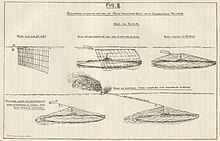 HMS Bayano with dazzle camouflage HMS Bayano with dazzle camouflage
| |
| History | |
|---|---|
| Name | Bayano |
| Operator | Elders & Fyffes, Ltd., Glasgow |
| Builder | Alexander Stephen and Sons, Ltd., Glasgow |
| Launched | 19 April 1913 |
| Completed | 1913 |
| Name | Bayano |
| Operator | Royal Navy |
| Fate | Torpedoed on 11 March 1915 |
| General characteristics | |
| Tonnage | 5,948 GRT |
| Speed | 14 knots (26 km/h; 16 mph) |
| Armament | 2 × 6 in (152 mm) guns |
HMS Bayano, built in 1913, was originally a banana boat for the Elders & Fyffes line. At the outbreak of the First World War it was commandeered by the Royal Navy on 21 November 1914 as an armed merchant cruiser. On 11 March 1915, it was torpedoed by the German submarine SM U-27 and sank within minutes, killing around 200 of its crew. Twenty-six survivors were pulled from the water.
Background

Once in the Royal Navy she was part of the Northern Patrol (10th Cruiser Squadron). The Admiralty had begun to use experimental indicator nets to counter German submarines. Indicator nets were made from strong thin wires, draped from the surface of the sea and kept buoyant with kapok, small buoys or glass globes. Sections of the net were held together with clips which (in theory) would part when the section was hit by a submerged submarine. The net would wrap around the vessel and indicate its presence via a buoy being pulled along the surface of the sea. The Admiralty established 21 net barrages, one of which was in the North Channel.
Sinking

In the North Channel, Bayano had reduced speed to avoid passing the net line in the dark, en route to Liverpool for coaling. At 05:15 on 11 March 1915, the ship was attacked by the German submarine SM U-27 about 10 nmi (12 mi; 19 km) west of Corsewall Lighthouse, Corsewall Point, Galloway, Scotland. The auxiliary cruiser sank in five minutes. Most of the crew was asleep and only 26 men survived to be rescued by the British steamer Castlereagh. Bayano's Lieutenant Commander Guy described Carr on the bridge, standing without fear waving goodbye while shouting "Good luck to you boys" before the ship disappeared under the waves.
Aftermath
Casualties
The captain and 194 other crew members were killed in the sinking.
Commemoration
Residents of the Isle of Man were greatly affected by the sinking as a number of bodies were washed up on the island. The funeral procession for the Bayano victims numbered in the thousands, even though the dead were not Manx. The Dominion of Newfoundland, part of the British Empire, was also hard hit. A dozen men from the Newfoundland Royal Naval Reserve were lost on Bayano.
Baralong incidents
Main article: Baralong incidentsU-27 was attacked and sunk in the Western Approaches in position 50°43′N 07°22′W / 50.717°N 7.367°W / 50.717; -7.367 by gunfire from Q-ship HMS Baralong. Her crew, including Bernhard Wegener, was killed in the so-called Baralong incidents.
Notes
- The secret project had been under way for some time and apparatus had been designed to run out the nets quickly. Flotillas of net drifters were to operate the nets, protected by armed yachts and other ships with guns and explosive sweeps. By 13 February 1915, nets had been laid across the Dover Straits and other drifter flotillas were ready for the North Channel and St George's Channel.
Footnotes
- Helgason 1995–2021.
- ^ mroh 2010.
- ^ Johnston 2015
- Corbett 2009, p. 18.
- Corbett 2009, p. 271.
- ^ Corkill 2013, p. 21.
- Smith 2015, p. 29.
- Hadley & Crickard 1996, p. 251.
- Bridgland 1999, pp. 20–55
References
- Bridgland, Tony (1999). Sea Killers in Disguise: The Story of the Q-ships and Decoy Ships in the First World War. Leo Cooper. ISBN 978-0-85052-675-2.
- Corbett, J. S. (2009) . Naval Operations. History of the Great War Based on Official Documents by Direction of the Historical Section of the Committee of Imperial Defence. Vol. II (pbk. repr. Naval & Military Press in association with the Imperial War Museum Department of Printed Books, Uckfield ed.). London: Longmans Green & Co. ISBN 978-1-84342-490-1.
- Corkill, Adrian (2013). Hostile Sea. Port Erin, Isle of Man: Selbstverl. ISBN 978-0-9540115-2-9.
- Hadley, Michael L.; Crickard, Fred W. (1996). Nation's Navy: In Quest of Canadian Naval Identity. McGill-Queen's University Press. ISBN 978-0-7735-1506-2 – via Archive Foundation.
- Helgason, Guðmundur (1995–2021). "Ships hit during WWI: HMS Bayano". Uboat.net. Retrieved 1 June 2021.
- "H.M.S. Bayano". Merseyside Roll of Honour. 2010. Archived from the original on 2 April 2015. Retrieved 12 March 2015.
- Johnston, Willie (12 March 2015). "Centenary of HMS Bayano disaster off the Galloway coast". BBC News. Retrieved 12 March 2015.
- Smith, Caroline (2015). Isle of Man in the Great War. Barnsley: Pen and Sword Books. ISBN 978-1-78383-122-7.
Further reading
- Osborne, Richard; Spong, Harry & Grover, Tom (2007). Armed Merchant Cruisers 1878–1945. Windsor, UK: World Warship Society. ISBN 978-0-9543310-8-5.
| Shipwrecks and maritime incidents in March 1915 | |
|---|---|
| Shipwrecks |
|
| Other incidents |
|
| 1914 February 1915 | |
55°3.0348′N 05°26.0976′W / 55.0505800°N 5.4349600°W / 55.0505800; -5.4349600
Categories: